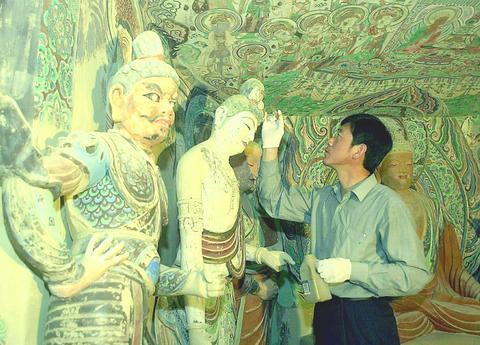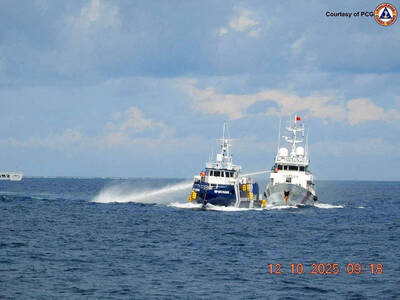The felt slipper in the glass case looks somewhat worn and dusty, but still serviceable. Hence the shock of its caption -- which reveals that its owner once pounded the Silk Road, the great ancient trade route, more than 1,000 years ago.
The Tibetan shoe, dating from the 8th or 9th century, is among a wealth of astonishingly well-preserved treasures from the Silk Road which have just gone on show at the British Library in central London.

PHOTO: EPA
Running from modern-day Iran to the west through central Asia and into China, with branches into Tibet and South Asia, the Silk Road -- a series of trading routes rather than a single highway -- saw commodities such as fabrics, spices and precious stones carried along its length.
More importantly for historians, with their passage came a transfer of ideas, technologies and beliefs.
Much of the route, especially that lying in what is now far-western China, is arid desert, meaning that a huge amount of usually perishable materials such as papers and fabrics have survived the centuries, often buried in sands.
The British Library's exhibition is largely drawn from items discovered by famous Hungarian-born explorer Marc Aurel Stein, who trekked along the Silk Road a number of times between 1900 and 1930.
His most astonishing discoveries came from caves in the ancient Silk Road town of Dunhuang, now in the western Chinese province of Gansu, which had been sealed in about AD 1000.
Among the thousands of documents and letters was the so-called Diamond Sutra, a Buddhist text translated in Chinese from AD 868, which is the oldest definitively-dated printed book in the world.
The exhibition mixes such treasures with many objects and documents giving a taste of ordinary people's lives along the great trade route,
One letter, found in Sogdiana, in modern-day Uzbekistan, was written by an angry woman to a husband who had abandoned her, forcing the woman to work as a servant for a Chinese household.
"I would rather be a dog's or a pig's wife than yours!" reads the curt missive, a domestic dispute which happened in the early 4th century, only to be rediscovered by Stein more than 1,500 years later.
This emphasis on the everyday was central to the exhibition, said curator Susan Whitfield of the British Library, who has been working with the material for a decade.
"The accidentalness of it all is what interests me. As a historian you work a lot with official histories, the great empires, the great courts, emperors and military campaigns," she said.
"But that's deliberately preserved history, it's been through several periods of interpretation by court historians. What's so fun about what we have from the Silk Road is that it is purely accidental.
"It's a window that would normally be completely closed off."
The items preserved in the desert sands were an arbitrary snapshot of life, Whitfield explained.
"Quite a lot of what is left is what you leave behind when you move house: broken bits and pieces, things you were given by somebody that you never really liked and never got around to throwing away," she said.
"That gives such an interesting view of human life, the detritus of human life. I very much wanted to show that."
Besides the ancient artefacts are a series of photographs and documents chronicling the exploits of Stein, who became obsessed with the region after reading as a boy about the campaigns of ancient conqueror Alexander the Great.
Last month plans were even agreed to build a so-called "new Silk Road," with 23 nations signing up to a scheme to build a vast network of highways running from Japan to Turkey.
This new focus on the region was helping to draw people into the exhibition, Whitfield said.
"By happy accident it's a good time to hold it," she said. "It's worked out very well."

Many people noticed the flood of pro-China propaganda across a number of venues in recent weeks that looks like a coordinated assault on US Taiwan policy. It does look like an effort intended to influence the US before the meeting between US President Donald Trump and Chinese dictator Xi Jinping (習近平) over the weekend. Jennifer Kavanagh’s piece in the New York Times in September appears to be the opening strike of the current campaign. She followed up last week in the Lowy Interpreter, blaming the US for causing the PRC to escalate in the Philippines and Taiwan, saying that as

Taiwan can often feel woefully behind on global trends, from fashion to food, and influences can sometimes feel like the last on the metaphorical bandwagon. In the West, suddenly every burger is being smashed and honey has become “hot” and we’re all drinking orange wine. But it took a good while for a smash burger in Taipei to come across my radar. For the uninitiated, a smash burger is, well, a normal burger patty but smashed flat. Originally, I didn’t understand. Surely the best part of a burger is the thick patty with all the juiciness of the beef, the

This year’s Miss Universe in Thailand has been marred by ugly drama, with allegations of an insult to a beauty queen’s intellect, a walkout by pageant contestants and a tearful tantrum by the host. More than 120 women from across the world have gathered in Thailand, vying to be crowned Miss Universe in a contest considered one of the “big four” of global beauty pageants. But the runup has been dominated by the off-stage antics of the coiffed contestants and their Thai hosts, escalating into a feminist firestorm drawing the attention of Mexico’s president. On Tuesday, Mexican delegate Fatima Bosch staged a

The ultimate goal of the Chinese Communist Party (CCP) is the total and overwhelming domination of everything within the sphere of what it considers China and deems as theirs. All decision-making by the CCP must be understood through that lens. Any decision made is to entrench — or ideally expand that power. They are fiercely hostile to anything that weakens or compromises their control of “China.” By design, they will stop at nothing to ensure that there is no distinction between the CCP and the Chinese nation, people, culture, civilization, religion, economy, property, military or government — they are all subsidiary